1912
In 1907, when Bruce Ismay, director of the White Star Line, decided to outmatch Cunard’s Lusitania and Mauretania, he did not intend to only build one or two vessels. The decision was that three vessels should be constructed. The first two, built almost simultaneously should be followed by a third. The three ships would be called Olympic, Titanic and Gigantic.
The White Star Line, owners of these new ships had commissioned its first vessel in 1871; the Oceanic. The company was British and was one of Britain’s two prime ship companies. The other one was the Cunard Line. But in 1902, when Bruce Ismay had been on White Star’s throne for three years, his company was devoured by the ever-expanding American company I.M.M. (International Mercantile Marine). The director of the I.M.M., J. P. Morgan wanted to establish a monopoly on passenger trade on the Atlantic. The purchase of the White Star Line was the largest affair ever for the I.M.M. But still, all officers aboard the White Star vessels were to be British, and completely controlled by the rather independent Ismay. It was for the glory of Britain these ships were built, not for America’s. The enormous amount of money that had to be raised in order to complete the three ships was not a problem; I.M.M. was a wealthy company, and White Star did not have to go to the British government for money, as Cunard had done with their prize tag for the Lusitania and the Mauretania in 1907.
It was rather embarrassing for the White Star Line when Cunard’s Lusitania and Mauretania entered service. Before that, White Star had had the largest vessel in the world; the Baltic at almost 24,000 tons, but with a service speed of only 16 knots. The Lusitania was 8,000 tons larger and could go 10 knots faster. The speed was not very concerning for Bruce Ismay, because White Star had been the icon of comfort rather than speed throughout its time, but the fact that Cunard had surpassed Baltic, and the rest of White Star’s quartet; the Big Four, in size was not acceptable. His new ships would be roughly 45,000 gross tons large, and would have a service speed of 21 knots. Not being in range of the Blue Riband of the Atlantic, Ismay’s ships would at least be able to claim they were the largest in the world.
In 1908, construction of the Olympic started at Harland and Wolff’s shipyard in Belfast, Ireland. Only months after, on March 31, 1909, the first steel of the Titanic’s keel was laid. The two mammoth gantries where Olympic and Titanic were built were originally constructed in order to handle the building of three ships. But as White Star Line’s new ships reached dimensions never dreamed of before, these three gantries had to be converted into two. On April 6 that same year the Titanic had gone so far in construction that she was fully framed and thanks to that the beautiful shape of the vessel was now becoming apparent. The man responsible for the Olympic-class’ exterior was Alexander Carlisle, a man that had had that mission for several other White Star ships. On the 20th October, 1910, the Olympic was successfully launched. By that time the Titanic’s hull was entirely plated. The Olympic was entirely completed on May 31, 1911, the very same day as the Titanic was launched. Titanic’s launch was a complete success, as her communicating flags at her stern spelled out.
The Olympic was when she entered the Atlantic trade route the largest moving object ever created by the hand of man. She quickly became a very popular ship amongst the passengers and the crew. This in spite of the fact that the ship was lacking enormously in life preserving lifeboats for all. Titanic was equipped with exactly the same inadequateness. This was common on the seas though. There had not been a change in the Board of Trade’s restrictions since the former century. Because in those times there was not any ship exceeding 10,000 gross tons, there was no restrictions concerning larger ships. As the Titanic was 46,328 gross tons large, she needed many more lifeboats than she carried. She was allowed to carry nearly 3,500 passengers, but there was only room in the lifeboats for about 1,200. But no man worried about this; the ship was the latest in the means of safety and housed 16 strong bulkhead inside her hull, and had a double bottom large enough for a man to stand straight in. Any two of her largest compartments could be flooded at any time and still the ship would remain afloat. In fact, all of the first four compartments could be filled without endangering the ship’s floatability. A damage larger than that was not thinkable. Olympic and Titanic, like so many other ships was rumoured to be unsinkable. The White Star Line itself never made this claim. It was the Stone and Lloyd (the company that made the watertight doors in ship’s bulkheads) that said that thanks to their material the new vessels were ‘practically unsinkable’. The public removed ‘practically’ and the vessels became unsinkable.
Though Olympic and Titanic were constructed from the same drawings, and were identical in most aspects, there were differences. On the Olympic was a promenade deck stretching the entire length of B-deck, but Ismay had noted that this area was hardly used by the passengers. The Titanic was therefore changed in this detail, making room for more first class cabins. Two of the parlour suites on this deck thus received a private promenade deck on the Titanic. If you want to see what it looked like, I recommend you to examine Rose’s cabin in the 1997 movie ‘Titanic’, which is parlour suite B52-56.
The Titanic was completed and dry-docked in Belfast Harbour Commissioners’ new graving dock on February 3, 1912, her funnels, masts and machinery now all fitted in place. Her maiden voyage was decided long before to occur on March 20, 1912. However, this did not happen. On September 20, 1911, the Olympic had accidentally collided with a British cruiser outside of Southampton. The cruiser was so badly damaged that she almost capsized, but managed to stay afloat. The Olympic had not escaped the event unscratched either. Her starboard side had been badly damaged and water had flooded two compartments. All of her passengers had been transferred to smaller vessels and brought back to shore. With the hole in her side mended with wooden planks, the Olympic sailed at low speed back to Belfast for reparations. Titanic was removed from her fitting out basin in favour for the Olympic. This delayed the Titanic’s maiden voyage and in an announcement in The London Times, October 11, 1911 the new date was said to be April 10, 1912.
When finally completed, the Titanic’s sea trials were to take place in the Belfast Lough on April 1, 1912. But because of bad weather, the trials were cancelled and moved to the next day. For the first time in her life, the Titanic’s life system started to pound. With a crew eager to see what the new ship was capable of, the Titanic went at high speed and then turned, making a circle with 3,850 feet in diameter. She also made a halt in 850 yards at 20 knots. The top speed clocked up to was 23.5 knots, much above her designed 21 knots. Had Lusitania and Mauretania not been, the Olympic and the Titanic would perhaps have taken the Blue Riband from Germany’s Deutschland. When trials completed, the Titanic was made ready for her departure to Southampton, from where she would sail eight days later to the New World.
On April 3, the Titanic reached Southampton and was tied up shortly after midnight at Berth 44. The following days, officers were installed in their new working place, cargo were loaded and stewards learned the ship by heart in order to help passengers when at sea. Everything went on just as it should do, except for one thing. Since February there had been a coal strike in Britain which stopped some ships from sailing. But because Titanic had had delays before, the White Star Line did not want to postpone her maiden voyage any further. Coal was scratched from the bottom of every I.M.M. ship that should not sail, and finally the Titanic was fuelled to the maximum. However, in order to save coal, only 25 of the 29 boilers were decided to be used.
At last the sailing day came. The Titanic was scheduled to depart on midday. Passengers and officers went around the ship looking like ants on their anthill. On the land beside the Titanic stood all relatives and friends who had come to say goodbye to their loved ones. The ship towered almost 70 feet from the water to the boat deck. To the top of one of the four huge funnels it measured almost 150 feet. The funnels themselves were about 75 feet high. One extraordinary thing a second class passenger could do now was to visit all first class public rooms, and that was certainly an opportunity one should have taken, because at sea the partition between the classes was rigorous.
At noon, Titanic’s assisting tugboats helped her out from her berth, and when clear, Titanic’s reciprocating engines started, and her two wing propellers started to revolve. Around her were numerous other vessels with inadequate coal supplies. Behind her to the right were Majestic, Philadelphia and St. Louis, all tied up alongside each other. Right ahead of the Titanic lay Oceanic and New York whom the 46,000-tonner had to pass. When doing so, a sort of suction appeared from the larger vessel’s hull, and the New York was pulled towards the Titanic, stern first. Of course, her mooring lines were securely fastened, but Titanic’s enormous power made them snap, one by one. The smaller ship’s stern approached closer and closer dangerously. But Titanic’s captain, Edward John Smith, immediately ordered the port propeller astern so that his ship would turn away from the New York. As no one was on board the New York, she floated absolutely free, unwittingly of the danger she caused. One of Titanic’s tugboats, the Vulcan, acted at once by throwing a mooring line on the New York and pulling her out of Titanic’s way. The flagship of the White Star Line and the world’s largest liner could at last begin her maiden voyage.
The Titanic’s first port of call was Cherbourg, France. There passengers and further cargo was to be loaded. The passengers were ferried out to Titanic by two tenders built especially for Olympic and Titanic: the Nomadic who took all first and second class passengers to the ship and the Traffic who ferried all steerage passengers to their temporary homes. Here John Jacob Astor, one of the richest men in America, stepped on board together with his newly wedded wife Madeleine, and their dog – an Airedale Terrier named Kitty. They had been on a honeymoon trip throughout Europe, which ended in Egypt, and now they were going home. Other famous persons that embarked here was Margaret ‘Maggie’ Brown, and Mr. and Mrs. Cardeza who occupied the starboard side parlour suite on B-deck, with its own private promenade deck. The port side mirror suite was occupied by Bruce Ismay, and not by Caledon Hockley.
After Cherbourg, Titanic steamed towards Queenstown, Ireland (today Cobh, Cork). There several emigrants waited for her, and a few second class passengers, but no one intended to travel in first class. Here, one Reverend Brown disembarked, taking with him many photographs he had taken on Titanic’s way from Southampton to Queenstown. These photos are today valued very high amongst many thankful Titanic-buffs. Since no footage exists from after that (except for wreck photographs), this is extremely interesting.
Then, the Titanic left the Old World in favour of the New. During these days there was nothing special the passengers could do. The ship offered numerous artefacts for spending time. But it was very odd for the emigrants, who had worked every day since childhood, to only spend their time by eating, sleeping and walking around. The weather was clear all the time, except for a very brief time of fog. The temperature kept falling, and soon no one could spend too much time up on deck. The Titanic’s maiden voyage was nearing its end as Sunday was about to turn into Monday.
The night on the North Atlantic between the 14th and 15th of April 1912 was a cold one. The fifth day of Titanic’s maiden voyage was coming to its end, and so far the weather had been good, although the temperature had dropped during the last hours. The water was just above freezing, and the air was getting colder too. In the wireless room, senior wireless operator John Phillips was busy sending private messages to Cape Race for relaying. The wireless equipment had been used extensively throughout the voyage, and a few ice warnings from other ships had been received and relayed. Although such warnings from the Nordaam, Empress of Britain, La Touraine, Caronia and Athinai had been posted for notice on the bridge, ice warnings from the Mesaba and Californian went by unnoticed by the officers.
By 10 p.m., first Officer William M. Murdoch relieved second Officer Charles H. Lightoller on the bridge. Lightoller informed Murdoch of the conditions and gave him the orders of the night; to maintain speed and course and keep a sharp lookout for ice. The Titanic raced on with a speed of approximately 22 knots.
By 11.30, the lookouts Frederick Fleet and Reginald Lee were waiting to be relieved from their posts by 12.00, after having finished their two-hour shift. The air had been clear all night, but by now a slight haze had settled on the horizon. Both men were well aware of how difficult it could be to spot icebergs, especially on a night like this one. There was no moon, and therefore no reflections on the surface of the berg. In addition to this, the sea was dead calm, and because of this there was no breaking water at the iceberg’s base.
The time was now approaching 11.40, and suddenly in the calm night, a ghostly figure appeared from the haze. Fleet would later describe it as ‘two tables put together’. He immediately recognised it as a menacing iceberg.
Fleet reacted instinctively and signalled ‘Object right ahead’ by striking thrice on the ship’s bell. He then reached for the electric telephone on his right side that connected the crow’s nest with the bridge. There Sixth Officer James Moody picked up the phone and asked Fleet what he had seen. The answer was short; ‘Iceberg right ahead!’ Moody thanked him and then relayed the message to first Officer Murdoch, who acted swiftly. He rushed to the engine room telegraph and ordered the engines stopped and then ‘Full Astern’ so that the ship would slow down. He then turned to quartermaster Robert Hitchens, who was at the helm, and ordered ‘hard-a-starboard ‘. In reality, this meant that the ship would turn to port. This might seem a little queer, however this type of command dated back to the days of sail, where putting the helm to starboard made the ship turn to port. Murdoch’s initial thought was to ‘port-round’ the berg and then turn starboard to avoid impact in the stern. As customary, Murdoch then turned to the panel where the controls for the watertight doors were located. By simply pressing and holding an electric button, Murdoch closed the doors that separated the sixteen compartments from each other. At the same time, a loud warning bell rang in the boiler rooms, far below in the ship’s hull.
Quartermaster Hitchens quickly put the helm to port when ordered, and the ship slowly began to turn. Up in the crow’s nest, Fleet and Lee held their breath. The iceberg was coming closer and closer. Its peak was about the same height as the boat deck, and its surface was somewhat dark, not bright white. About half a minute later, the collision came, on the starboard side. The berg scraped along 300 feet of the ship’s hull, making rivets pop and buckling hullplates along the way. The impact, however, was not very violent. The two lookouts hadn’t heard that much noise, and as the berg disappeared in the night, Fleet turned to Lee and said: ‘That was a narrow shave!’
Captain Smith, who had been asleep in his cabin, had felt the impact and soon appeared on the bridge, just as fourth Officer Joseph Boxhall. Smith asked Murdoch what the ship had hit. Murdoch explained what had happened and how he had acted but that it had been too late. Captain Smith ordered the watertight doors closed, but Murdoch had already done this. The two men went out on the starboard bridge wing to try to get a sighting of the iceberg, but it had already disappeared into the darkness.
Back on the bridge, Captain Smith ordered Boxhall to investigate the forward part of the ship and then report back as quickly as possible with a damage report. Boxhall did so, and a quarter of an hour later, he returned to the bridge. He told Captain Smith that he had found no sign of any damage above F-deck, but that Postal Clerk Smith had told him that the lower mailroom was flooding, and that the mail was being moved to a higher level.
Captain Smith thanked Boxhall, and asked him to calculate the ship’s current position in case they would be forced to call for assistance. Boxhall hurried to the chart room, and by the stars, the ship’s course and his own estimate of the speed, he roughly calculated the position. It was scribbled down on a piece of paper, and handed to the master.
Thomas Andrews, the ship’s chief designer who was on board for the maiden voyage, had spent most part of the evening in his cabin. He was called to the bridge, and he arrived there a few minutes later. Smith asked him to accompany him on an investigation round below decks. They left, and ten minutes later they returned. Andrews explained the size of the damage. During the first ten minutes since the collision water had risen 14 feet above the keel in the foremost compartment. The iceberg had penetrated five and a half of the watertight compartments, and the first five were now flooding. The terrible truth now dawned on the men present on the bridge. The Titanic’s unsinkability was based on that she could stay afloat with any of her two compartments flooded. She would even stay afloat if her four foremost compartments were breached, but with five compartments flooding simultaneously, she could never be expected to stay afloat. The sheer weight of the water would inevitably bring her down at the head. The water would then spill over the top to the next compartment, filling it, and so on. The Titanic was doomed.
The bridge lay quiet for a brief moment. Then, Captain Smith broke the silence with a simple question: ‘How much time have we got?’ Andrews made a quick calculation on a small piece of paper and then answered: ‘One hour. Possibly two.’ Smith then ordered the lifeboats to be uncovered.
The time was now a couple of minutes past midnight. Captain Smith went to the wireless room and handed the ship’s position to Phillips, asking him to send the distress signal CQD, along with Titanic’s call signal, MGY.
Down in the boiler rooms, there was much activity. Since the collision water had been rushing in through the hull. The engines were stopped and the furnaces were now being raked out, to avoid a possible explosion. In the foremost boiler rooms, firemen had to abandon their posts immediately because of the quick flooding of these.
The passengers had experienced the collision in many different ways, according to in which class they were travelling. Among the single male passengers in third class, who were located down below in the ship’s bow, the impact had been very violent and water was now entering their cabins. As a complete opposite, people in first class didn’t notice the collision that much, if they even did at all. In the smoking room several men were gathered, and most of these experienced the impact as a grinding, less alarming sound. Some went out on the promenade space on A-deck out of curiosity but there was nothing to see, the iceberg was already gone.
Lawrence Beesley, a teacher travelling in second class, had been up reading when the collision occurred. He felt as if the engines were speeded up and the vibration in his mattress increased. The thought of an accident didn’t occur to him. But after a while he noticed that the engines were stopped, and this made him curious. He went up on deck to ask what was the matter. But the decks were quiet and deserted and he decided to go back to his cabin. On his way down he noticed that the stairs was tilting. This was also noticed on the bridge where the commutator showed a list of two degrees towards the bow and five degrees to the starboard side.
Fourth Officer Boxhall had now noticed a ship that was visible on the horizon on a distance of about five miles. He told Captain Smith about this, and was given permission to start firing rockets. Boxhall ordered Quartermaster George Rowe to fire a rocket every fifth minute, and so the first rocket was fired at about 12.45 a.m.
George Rowe was probably the last crewman onboard to be notified of the accident. He was on watch on the docking bridge, situated on the poop deck, at the time of the collision. As he suddenly saw a great mass passing the ship on the starboard side, his first thought was that they had encountered a large sailing vessel in mid-ocean. Then, as the first lifeboat was lowered about an hour after the collision, Rowe was surprised. Why was one of the ship’s lifeboats in the water? Using the electric telephone that connected him to the bridge, he reported that one of the lifeboats was adrift. On the bridge, it was suddenly realised that Rowe had been forgotten, and he was immediately ordered to report to the bridge. There, he was informed of the situation.
At the same time, wireless operators John Phillips and Harold Bride were busy sending distress calls into the night. Several ships replied, but they were all too far away to be of any assistance. The closest ship that had been heard from so far was the Cunarder Carpathia, but she was still a considerable 58 miles off. The Carpathia was an older vessel on her way from New York to the Mediterranean with a speed of 14 knots when she intercepted the Titanic’s signals. The ship’s only wireless operator, Thomas Cottam, was actually about to turn in for the night when he suddenly heard the distress calls from the stricken Titanic. At first, he couldn’t believe what he heard, but soon he realised what was happening. He wrote down the message and the Titanic’s position, and then quickly made his way to the Carpathia’s bridge. There he met First Officer Dean, and together they hurried to the master’s cabin. In the rush, they entered without knocking on the door first, and Captain Arthur Rostron was very upset about this insolence. However, when told of the situation, he immediately realised that crewmen who neglected to knock before entering his cabin was the least of his concerns at the moment. He quickly ordered the ship turned around, to head north for the Titanic’s given position. Although his ship was in travelling in ice-infested waters, he ordered ‘Full Ahead’, knowing that many lives could be at stake.
Full ahead was an understatement. All the exhaust steam was pressed into the old engines. The hot water was turned off, and almost all the energy produced contributed to the ship’s propulsion. That now-famous night, the Carpathia managed to keep an average speed of between 17 and 18 knots, a speed she wasn’t really designed – or thought – to obtain. Knowing what a great risk he was taking when driving his ship at such high speed through icy waters, Rostron took every precautions that came to his mind, and posted extra lookouts on the forecastle of the ship. When en route for the Titanic’s position, Rostron asked Cottam to contact the stricken liner and inform them that the Carpathia was on her way – she would be with them in about four hours…
On board the Titanic, passengers were now ordered to put their lifebelts on and come up to the boat deck. Captain Smith knew that his vessel had lifeboats for just about half of the people on board, and in the ice-cold water, he knew that no one could survive for long. The master was also aware of the importance of avoiding panic to break out. Therefore, passengers were asked to come to the boat deck, but they were not told of any danger.
Soon passengers began crowding the deck, mostly from first and second class. People in third class found their way to third class promenade spaces at most, and these were located on the bow and the stern. Getting up to the boat deck proved to be a problem for many of these people, on one hand because they simply never had been there and on the other because many of them didn’t speak English. On the boat deck, the lifeboats were being uncovered. A task that was harder than one might think, because exhaust steam was being ventilated through the funnels, and the noise it created made communication between the crewmembers almost impossible. After a while though, the exhaust steam was gone, and the noises stopped.
Now that the boats had been made ready, the order was ‘Women and children first’. First Officer Murdoch was in charge of the lowering of the boats on the starboard side, all with odd numbers, and second Officer Lightoller handled the port side boats, these with even numbers. No matter what side, people were still reluctant to enter the lifeboats. On this great ship, it was hard to see that something was wrong, and few wanted to swap this lighted, seemingly safe ship for a relatively small wooden craft on the dark and cold North Atlantic.
There was no organised handling of the lifeboats. Very few of the crewmembers knew to which boat station they were posted, and the only boat drill that had been carried out was in Southampton, before the passengers embarked. This drill had been very simple; boats number 11 and 15 had been lowered and raised, simply to see if the lowering equipment was in order.
At 12.45 a.m., the first lifeboat was lowered under the supervision of first Officer Murdoch and fifth Officer Lowe. It was number 7, on the starboard side. With a total capacity of carrying 65 people, this boat contained only 28, all being first class passengers except for three crewmen. At the same time, Fourth Officer Boxhall was desperately trying to contact the ship he could see on the horizon with a Morse lamp. But the ship did not reply, and Boxhall could see the ship slowly turning away, and disappearing out of sight.
It was now 12.55 a.m. The bow of the Titanic was not notably deeper in the water, and the first boat from the port side, number 6, was lowered. Second Officer Lightoller, who was in charge of the lowering was very firm in following the order ‘Women and children first’, and let very few men enter the boats even if there were was room for them and no women could be seen close by. But as boat number 6 was being lowered, the women on board it discovered that there was only one man present in the boat. They called up to the boat deck, and Lightoller allowed first class passenger Major Arthur Peuchen to lower himself into the boat on one of the falls. Boat number 6 left the Titanic with 28 people.
Almost at the same time, boat number 5 was lowered from the starboard side. Being able of 65 people, this boat held 43. Third Officer Pitman, who was responsible for the loading of the boat, let several men into the boat, as he could see no women on the decks. Bruce Ismay, the chairman of the White Star Line, stood by one of the davits and waved on of his arms ferociously whilst loudly telling the crewmen to lower the boat. Fifth Officer Lowe, who probably didn’t recognise his employer, told Ismay to shut up; he was disturbing the procedure. Ismay quietly walked away from the scene.
At 1 a.m. boat number 3 was lowered from the starboard side, carrying 32 people. A few minutes later, boat number 8 went down the port side with 39 onboard. Both boats had a capacity of 65. Isidor Straus, owner of the Macy’s department store, and his wife Ida were offered room in boat number 8. However, Mr. Straus refused to leave the ship before every woman was safe, and Mrs. Straus refused to leave her husband. They stayed onboard, and eventually, they perished together.
By 1.10 a.m., it was time for boat number 1, situated on the starboard side near the bridge, to be lowered. In the aftermath of the tragedy, this boat was to become the most debated one. With a capacity of 40 people, this boat left the Titanic with only 12 in it, among these Millionaire Sir Cosmo Duff Gordon, his wife, her maid and seven crewmen.
On the boat deck, the ship’s band with leader Wallace Hartley had gathered, and they were now playing cheerful ragtime tunes to calm the passengers. The boats were one by one still being lowered. At about 1.20 a.m., boats number 9, 10, 12 and 14 were lowered. The tilt towards the bow was now more apparent, and people were now beginning to realise that the Titanic would founder. Therefore, boats were now being loaded with more people, but none of them was completely filled. Some now began to jump into the water from the ship’s side in hope of being rescued by one of the boats already afloat. The officers had all been handed a pistol, and Fifth Officer Lowe was now forced to fire warning shots down the ship’s side as a group of panicking men tried to enter a lifeboat by force. Fortunately, Lowe was able to keep the men at a distance. Millionaire and playboy Benjamin Guggenheim went to change into his evening clothes. He is reported to have said; ‘We have dressed in our best, and are prepared to go down as gentlemen’.
In the wireless room, the two operators were still sending distress calls. Although the situation was now very serious, none of the replying ships actually understood that the Titanic would sink. By 1.25 a.m. Titanic’s sister ship, the Olympic, who was far off, answered one of the calls: ‘Are you turning and coming to us, or should we come to you?’ To this, Phillips simply answered ‘We are putting the women into the boats’.
In the engine room, the engineers were working to keep the steam up in boiler rooms number 2 and 3, to keep electricity running for the lights and pumps. It was now 1.30 a.m., and the bow of the ship was disappearing in the icy water. People were now panicking, and boat number 11 was now lowered, carrying five people more than it was designed for, a total of 70. Close by, a near-accident took place. Boat 13, with 64 people onboard, reached the water but its passengers were unable to detach the falls. The boat drifted alongside, towards the stern of the Titanic and ended up just below boat number 15, which was being lowered. In boat 13, in which Lawrence Beesley was present, someone managed to produce a pocket knife and was able to cut the falls so that the boat could come clear of the danger above.
Quartermaster George Rowe had now fired the last of the eight distress rockets. But in the wireless room, signals were still being sent, although now more desperate ones. By now, the new distress signal, SOS, was also used as well as the old one.
The time neared 1.40 a.m. and boat number 16 was lowered with about 45 people onboard. Now there was only two regular lifeboats left, namely number 2 and 4. But in addition to her sixteen lifeboats, Titanic also carried four so-called Engelhardt collapsibles, numbered A, B, D and C. These were boats with wooden bottoms, and canvas sides that was raised when the boats were to be used. Collapsible C was now hanging by the davits originally occupied by boat number 1, on the starboard side. Chief Officer Henry Wilde supervised the boat, and when his calls for more women were unanswered, Bruce Ismay stepped into the boat. Although he had helped in the loading of several boats throughout the night, he would later be strongly criticised for entering a boat and thereby saving his own life when so many others were lost.
By 1.45 a.m. boat number 2 left Titanic with about 20 people, among them Fourth Officer Joseph Boxhall. Ten minutes later, boat number 4 was lowered, carrying numerous passengers from first class. Among them was 19 year-old Madeleine Astor, the wife of real estate-tycoon John Jacob Astor. As Mrs. Astor was pregnant, Mr. Astor asked Lightoller if he could accompany her into the boat. Allowing no men into the boats, Lightoller told him no. Accepting this, Mr. Astor stepped back and waved his young bride off in the two-thirds full lifeboat. Now, there were only three boats left, collapsible A, B and D, together with about 1,500 people. Collapsible D was now suspended in the davits earlier used to lower boat number 2. To avoid a rush to the boat, Lightoller ordered some crewmen to form a circle around it and to only let women and children through. By 2.05 a.m., the boat was lowered carrying 44 people. The only boats now left were collapsibles A and B, and they were still lying on the roof of the officer’s quarters.
The Titanic’s bow was now completely submerged. Captain Smith made his way to the wireless room, and relieved the two operators from their duty. Phillips continued to send signals for a little while, but the power was now weak, and the range of the wireless apparatus was greatly decreased. Nothing more could be done from here, and the two men left their post to try to save themselves. What happened to Captain Smith will forever be a mystery.
On the roof of the officer’s quarters, just by the base of the foremost funnel, Murdoch and Lightoller, together with several crewmen, were busy trying to get the two remaining collapsibles readied for loading. But at that moment, the ship made a great dive, causing a massive wave flowing over the bridge. Lightoller was unfortunate with boat B, which was turned over and washed away along with numerous people, among them Lightoller himself. Murdoch had been able to get boat A loose, but also this boat was washed off. Although partially flooded, it managed to stay afloat, and a few people managed to climb onboard. Murdoch was never seen again. Some testimonies claim that he shot himself, but it is more probable that he drowned or froze to death in the cold water.
The weight of the water in the now flooded bow made the expansion joint between the first and second funnel give slightly away. The wires that held the first funnel could not bare this strain, and snapped one by one. The tall funnel crashed forward and crushed the bridge wing on the port side and many people who happened to be in the surrounding waters. The wave made by this enormous construction falling into the water managed to wash collapsible B away from the sinking liner.
On the boat deck, the band played on. The last tune that was played has been the topic of much debate throughout the years. The classic myth is of course that the hymn ‘Nearer My God To Thee’ was played, but others say different. Junior wireless operator Harold Bride testified that the band played a melody called ‘Songe d’Automne’, and others said that ragtime tunes were played until the very end. None of the musicians survived, and they were eventually made the immortal heroes of the disaster.
After the two and a half hours that had now passed since the fatal collision, everything happened very quickly. With 1,500 people still onboard, the Titanic’s stern rose higher and higher into the cold night air. At 2.17 a.m., the light that had been burning flawlessly the whole night flickered once, and then went out completely. It became pitch dark, and people in the lifeboats could only make out a giant dark silhouette against the night sky. Then, a terrible noise sounded, and many people now understood that the end was nigh. The hull of the Titanic, broke in two between the third and the fourth funnel, and a large portion in this area was literary devastated. It was here that the heavy machinery was located, and this, combined with the weight of the stern that rose up in the air, was more than the hull could take. The stern fell back into the water, and some of the survivors later said that it looked like the ship was coming back. But as the bow, still attached to the stern by the keel, started to sink to the bottom, the stern was again pulled up in an almost pendicular position before it detached from the bow. The stern stood on end like this, and bobbed like a cork for a minute or so but then, it too started its final descent. The water rushing in quickly and violently pressed the air out of the stern. It was smashed from the inside.
And then the Titanic slipped beneath the surface. It was now 2.20 a.m., April 15th, and the only thing left of the once so proud liner was 20 small lifeboats, and 1,500 people who were now freezing to death in the ice-cold water.
All that was now, was silence. It was a very calm night on the North Atlantic. The last sounds heard from the Titanic had been muffled explosions from the depths, and soon another sound echoed through the night. This was the cries of the people left in the water, and they were now freeing to death. This sound would haunt many of the survivors throughout their whole lives.
Scattered in the surrounding waters lay the 20 lifeboats. Many of them were only half-filled, but they all lay still in the water. Eventually the cries from the dying died out, and now one lifeboat made it back to the scene. It was number 14, under the command of Fifth Officer Lowe. Having moved women and children into other boats, Lowe order the boat turned for the wreck site. Hundreds of bodies floated in the waters, together with wreckage from the Titanic. Four people were pulled out of the water, but one of them died later from exposure. Lowe also encountered the half-flooded collapsible boat A, in which twelve men and a woman stood with water up to their knees. They were transferred to collapsible D, and this was taken in tow by boat 14. Collapsible A, still carrying three bodies was set adrift, at it was later recovered by the White Star liner Oceanic about 30 miles from the wreck site. The three bodies were then buried at sea. Now, the 700 occupants of the lifeboats could do nothing but wait. It was in the middle of the night, and not many knew if help was on the way or not.
Meanwhile, the Carpathia swiftly made her way through the night. Preparations to receive the survivors was made; coffee, tea and hot soup was prepared for those who suffered from exposure, and every area of the ship was made ready to accommodate the extra passengers. The davits were swung out to raise the Titanic’s lifeboats. The passengers of the little Cunarder had been alarmed when so much activity was going on in the middle of the night. Therefore, crewmen were told to inform the passengers that the Carpathia was on her way to assist a stricken vessel, there was no danger of the ship’s own safety.
By 2.30 a.m., according to the clock on board the Carpathia, a small, green light was sighted on the horizon. This was a signal flare brought into one of the lifeboats. Half an hour later, Captain Rostron ordered rockets to be fired every fifteen minutes. By 3.35 a.m., the Carpathia was so close to the Titanic’s given position, that the Titanic would have been visible, had she still been afloat. Here and there, green lights were sighted, but these were so close to the water, that they could only come from very small boats. There was no longer any hope of finding the Titanic still afloat.
By 4 a.m., the first lifeboat was sighted from the bridge of the Carpathia. It was number 2, with 25 people onboard. Ten minutes later, the first survivors were climbing ladders up the side of the Carpathia. The boat contained only women, except for the man in charge, Fourth Officer Joseph Boxhall. Captain Rostron sent for Boxhall, and still soaking wet, Boxhall reported to the bridge. There he informed Captain Rostron that the Titanic had foundered at 2.20 a.m.
Carpathia continued to search the waters, stopping by each lifeboat to recover the survivors. Some of them, mostly women and children, were hoisted up the sides in canvas bags by the ship’s crew. Most of the men had to climb the ladders that had been suspended down the ship’s sides. When on board, people were brought below decks where they were given food and blankets. The ship surgeon, Dr. McGee, examined the most shocked survivors.
The rescue went on into the dawn and the morning. By 6.15 a.m., survivors from collapsible C was recovered. At 7 a.m., boat 14 with collapsible D in tow, was spotted. On the upturned collapsible B, second Officer Lightoller stood, along with other men. Throughout the night, they had been forced to stand up and lean to the right and left on Lightoller’s command to keep the boat in balance. The boat was almost completely under water, and Lightoller had to use his whistle to make the crew on the Carpathia even notice them.
Collapsible B was the last boat to reach the Carpathia, at about 8.30 a.m. Second Officer Lightoller was the last survivor to board the rescue ship. It was now understood how many lives that had been lost during the night. Out of the Titanic’s 2,200 passengers and crew, only 700 had been rescued. In a last attempt to find any more survivors, the Carpathia circled the waters. As the ship passed over the Titanic’s given position, Captain Rostron held a memorial service in the ship’s dining room.
On the deck, the Titanic’s lifeboats were salvaged. Thirteen were hauled aboard, and the remaining six; number 4, 14, 15, B, C and D were set adrift. As the last lifeboat was recovered, the ship Californian appeared in the west. At 5.50 a.m. they had been told by other ships what had happened over the night. The Californian, which had been lying still all night, had then headed towards the Titanic’s position. Now, Rostron informed the Californian’s master, Stanley Lord, what had happened.
Then, the Carpathia made a final pass over the wreck site. There was not much wreckage anymore, just a few deck chairs, lifebelts and numerous every-day objects. As a lonesome reminder of all those perished, a body was seen floating with its face down in the water. The Carpathia’s search for survivors was called off, and she set her course for New York.
As soon as the 705 survivors were brought into shore by Cunard’s Carpathia on April 18th, many of them were called to an American Senate Investigation. Bruce Ismay, who fortunately had managed to escape from the Titanic, was not allowed to sail back to Britain immediately with the Cedric, which had been his intention. In spite of his weary condition, he was cross-examined for several days by a Mr. William Alden Smith, who lengthened the disaster hearings by not knowing a thing about ships or the life at sea. When the hearings finally were over, a new British one started off in London. Though being better than the American one, many of the witnesses was tired and wanted to forget.
When both hearings were over it was concluded that the Board of Trade’s restrictions should be changed. There should always be lifeboats for all aboard. No one was really blamed for the disaster, so a sinner had to be found. He was Captain Stanley Lord of the Californian, who had turned his radio equipment off during the night, because his only wireless operator had to sleep. Since the Californian was the vessel that lay closest to the Titanic (about 20 miles), Lord was the perfect sinner. Arthur Rostron, the captain of the Carpathia, the ship that had saved the 705 people in the boats, was 58 miles from the Titanic when he got the distress call.
The Olympic and several other ships were immediately fitted with enough lifeboats and underwent major changes in the hull structure. Germany’s new Imperator was launched only a month after the disaster, and you could see how fast her over 80 lifeboats was fitted.
The Olympic went on sailing without her sister for a couple of years, but eventually the Britannic (supposed to be Gigantic, but changed after the disaster) was launched. Unfortunately, World War 1 broke out and the Britannic was turned into a hospital ship, and sunk by a mine in the Mediterranean in 1916. White Star’s three ship service from Southampton to New York was not established until the early twenties when the 56,000-tonner Majestic (the ex-Bismarck) replaced the Britannic and the 35,000-tonner Homeric (the ex-Columbus) replaced the Titanic. By the early forties all of these ships had gone to the scrap yard as requirements for the Depression. In the 1950s, a new interest in the old liners of the Olympic-class vessels arose, when Walter Lord’s ‘A Night to Remember’ was published. A few years later a movie, based on the book came out. Several societies were founded, among them ‘The Titanic Enthusiasts of America’, later renamed ‘Titanic Historical Society’.
In 1985 a Franco-American expedition under the command of Dr. Robert D. Ballard located Titanic’s wreck at 12,000 feet of water, south-east of Newfoundland. Her condition is in a sad state. She is, like so many survivors had said, broken in two between the third and the fourth funnel. The funnels themselves are gone and only fragments of them were found on the ocean floor. In spite of this, lots of her upperworks are intact. This first expedition did not touch anything, but later expeditions have brought numerous artefacts to the surface. In 1998, a large piece of Titanic’s hull from C-deck was raised and preserved. Then, of course, there was James Cameron’s blockbuster movie ‘Titanic’, which premiered in 1997. The main characters in the film; Jack Dawson (Leonardo DiCaprio) and Rose DeWitt Bukater (Kate Winslet) are fictional, but thanks to this movie, the number of Titanic-buffs seems to increase more and more as time goes by. In many ways, the Titanic has never been more alive than she is now.
Specifications
- 882.9 feet (269.68 m) long
- 92.6 feet (28.2 m) wide
- 46,328 gross tons
- Triple-expansion engines powering two wing-propellers, and one exhaust steam turbine powering the centre propeller
- 21 knot service speed
- Passenger capacity of 2,435 people

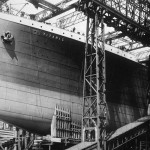
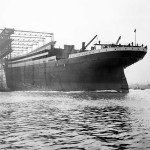
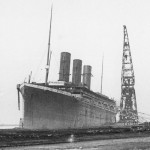
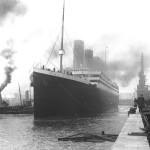
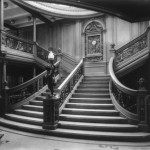
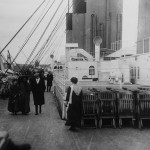
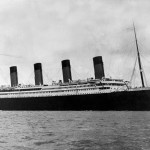
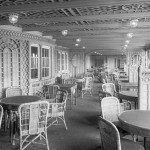
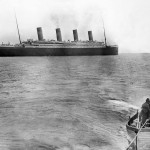
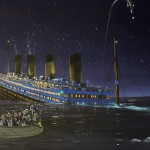
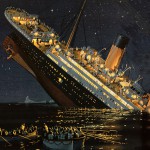
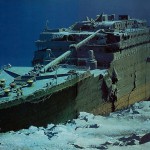
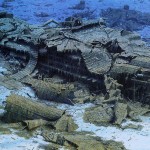
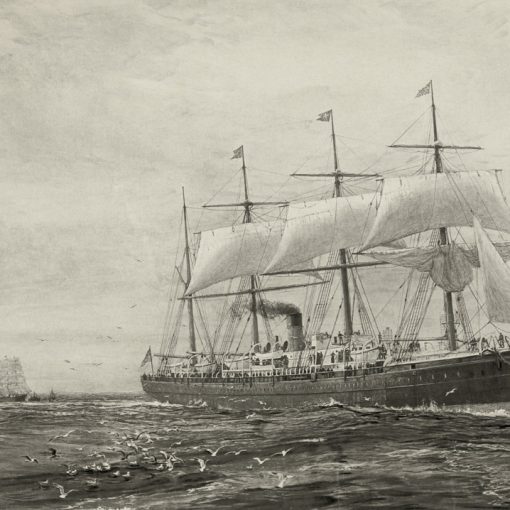
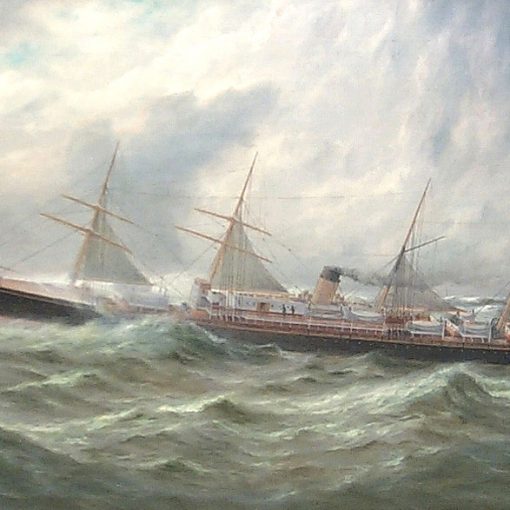
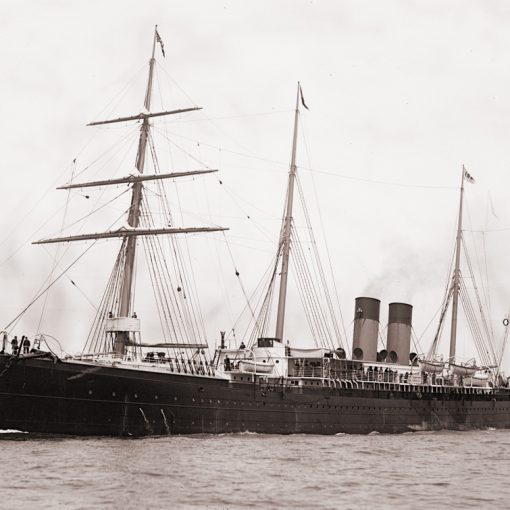
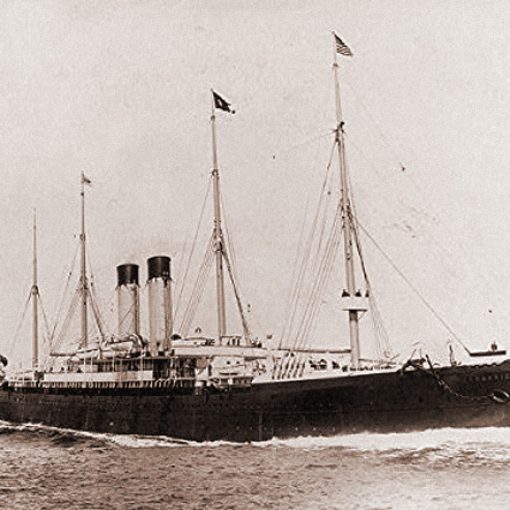
2 thoughts on “Titanic”
A story well told. The writing, however, leaves much to be desired. Grammar, punctuation, and sentence structure are abysmal. This should have been proof-read by someone who understands the English language.
Mesmerizing storytelling. Perhaps the finest written description I have yet read. It’s midnight here. Dark and quiet as I slowly read this account. Afterward I went outside into the 37F degree night. Raining slightly. Purposely stood alone until I was very very cold. Thought about that night. Trusting lives lost. The arrogance of technology. And our never-ending belief in it. Compliments to the author. Thanks.